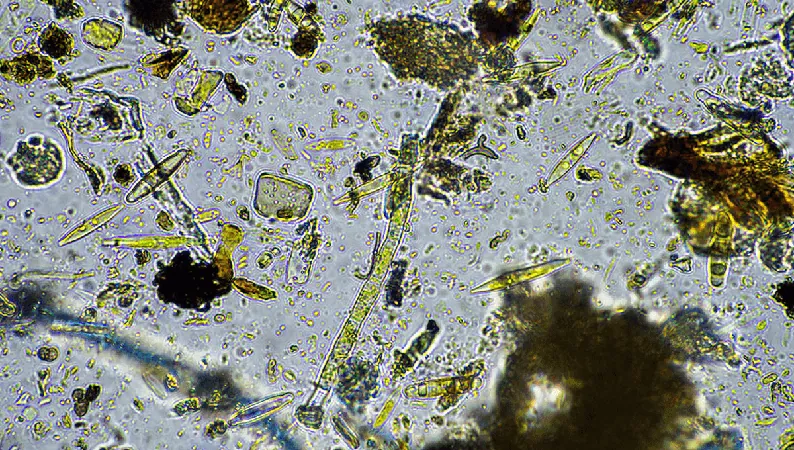
Revolutionary Discovery: New Microbial Class Unveils Secrets of Earth's Hidden Soil Ecosystem!
2025-04-08
Author: Arjun
In a groundbreaking revelation that feels straight out of a science fiction novel, a team of microbiologists from Michigan State University has unearthed a new category of microbes thriving deep beneath our feet, within what scientists refer to as the Critical Zone. This essential ecological layer ranges from the tops of trees to depths reaching 700 feet (approximately 213 meters), yet remains vastly unexplored.
Remarkably, these researchers have ventured into this uncharted territory, retrieving soil samples from depths of up to 21 meters (70 feet) in Iowa, USA, and China. According to leading microbiologist James Tiedje, “The Critical Zone supports most life on the planet, regulating critical processes such as soil formation and nutrient cycling. It's vital for food production, water quality, and overall ecosystem health. Despite its significance, much about the deep Critical Zone remains a mystery.”
The team's meticulous analysis revealed a startling discovery: a previously unclassified group of microbes dubbed CSP1-3. DNA extracted from the sampled soils revealed that these organisms share ancestral ties to ancient hot springs and freshwater environments, having adapted over millions of years to thrive in the barren landscapes of the Critical Zone.
Contrary to the belief that these microbes may exist in dormant forms, Tiedje highlighted that they are, in fact, very much alive and gradually multiplying. "In some samples, CSP1-3 comprised more than 50% of the microbial population—an extraordinary dominance not seen in surface soils," Tiedje noted. This suggests that these microbes have uniquely evolved traits that allow them to flourish in such nutrient-scarce environments.
So how do these resilient microbes manage to survive under such harsh conditions? The key lies in their ability to scavenge essential elements like carbon and nitrogen that seep down from the nutrient-rich top soils above. The research indicates that these deep soil lineages are primarily "mixotrophs," capable of synthesizing trehalose, a compound crucial for energy storage that enables them to endure resource-limited conditions.
Furthermore, the CSP1-3 microbes employ sophisticated mechanisms to maximize energy production, including trace gas oxidation and heterotrophic fermentation, which empowers them to survive during periods of nutrient scarcity and low oxygen availability. The unique feature of aerobic carbon monoxide oxidation among these microbes may also provide insights into their potential for thriving even in the toughest environments.
Moving forward, the researchers are gearing up for an ambitious project aimed at cultivating these intriguing microbes in a lab setting. This undertaking poses a significant challenge, as replicating their natural habitats—particularly the high temperatures reminiscent of their hot spring origins—is no simple feat. Nevertheless, if successful, the implications could be monumental.
As Tiedje pointed out, “The biochemistry and physiology of CSP1-3 reveal distinct characteristics that could lead to the discovery of valuable genes. One of our greatest mysteries remains: how these microbes metabolize stubborn pollutants. If we crack that code, we might unlock solutions to some of humanity’s most pressing environmental challenges.”
This unprecedented study not only sheds light on the hidden diversity of life within Earth’s soils but also opens up exciting possibilities for sustainable environmental practices and pollution mitigation efforts. Who knew that beneath our feet lies a world of microbes just waiting to be discovered? Stay tuned as researchers dive deeper into the secrets of the Critical Zone!

 Brasil (PT)
Brasil (PT)
 Canada (EN)
Canada (EN)
 Chile (ES)
Chile (ES)
 Česko (CS)
Česko (CS)
 대한민국 (KO)
대한민국 (KO)
 España (ES)
España (ES)
 France (FR)
France (FR)
 Hong Kong (EN)
Hong Kong (EN)
 Italia (IT)
Italia (IT)
 日本 (JA)
日本 (JA)
 Magyarország (HU)
Magyarország (HU)
 Norge (NO)
Norge (NO)
 Polska (PL)
Polska (PL)
 Schweiz (DE)
Schweiz (DE)
 Singapore (EN)
Singapore (EN)
 Sverige (SV)
Sverige (SV)
 Suomi (FI)
Suomi (FI)
 Türkiye (TR)
Türkiye (TR)
 الإمارات العربية المتحدة (AR)
الإمارات العربية المتحدة (AR)